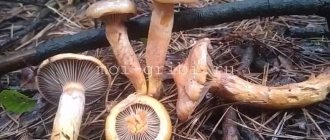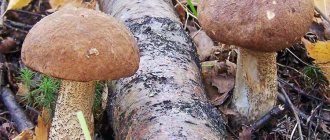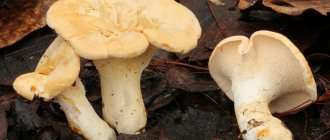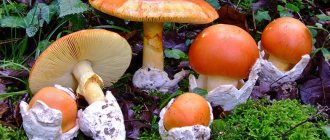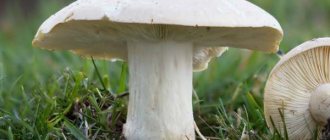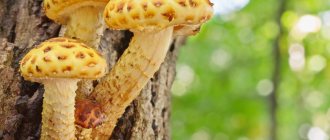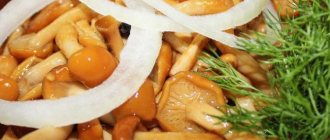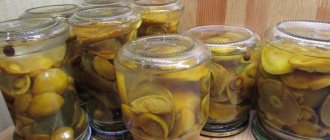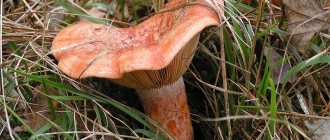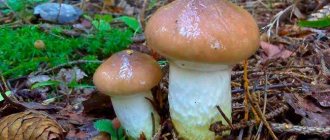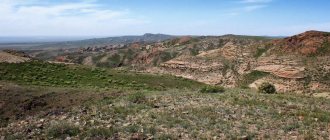We are glad to welcome you to the blog. The mushroom season is in full swing, so our topic today will be edible mushrooms, the photo and name of which you will find below. There are many types of mushrooms in our vast country, so even experienced mushroom pickers cannot always distinguish edible from inedible. But false and poisonous species can spoil your dish, and in some cases even cause death.
In the article you will learn what edible mushrooms are, what types they are divided into, where they grow and what they look like, which mushrooms appear first. I will tell you what benefits they bring to your body and what their nutritional value is.
Botanical description of the mokrukha mushroom
Mokruhi (Gomphídius) are large mushrooms, the height of which can be more than 10 cm, their cap reaches the same size. Depending on the species, young specimens have convex or conical shapes. And in the “oldies” they are smooth with a slightly concave center.
The pulp of different representatives of mokruha differs in color variety. It can be white-gray, bright orange, brown or pink-white, turning pink or red at the break.
The mushroom stems are massive, thickened at the bottom, they are light cream and, like the caps, slimy. There is also a ring of mucus on top of them. The dense flesh changes color from yellow (bottom) to off-white (top).
Appearing in mid-summer, these mushrooms bear fruit almost until frost. There are single specimens, but more often these gifts of the forest grow in small families.
Places where mokrukhs grow
Wetweeds are far from uncommon in coniferous or mixed forests. They can be found in moss under pine, spruce or fir trees. Mass gathering of mushrooms, which are avoided by beginner mushroom pickers but appreciated by experienced ones, occurs in late summer and early autumn.
Mokrukhs prefer calcareous soils, they love elevated places and thinned forest plantations. They are often found in the vicinity of butterflies. In Russia they grow everywhere only in Siberia, the Far East and the North Caucasus. In European territory, mushrooms can be found less frequently, mainly in areas with snowy winters and hot, short summers.
Collection time
Moss fly mushrooms bear fruit en masse from July to September inclusive, however, each species has its own start and end dates for ripening. Thus, the first fissured moss mushrooms appear in the last ten days of June, and single specimens are found until the end of September, although they are collected in large quantities only from the second half of August until the tenth day of the first month of autumn.
The collection period for the Polish mushroom is from June to November; it is often found when other tubular mushrooms can no longer be found.
In Russia, green moss mushrooms red ones do not bear abundant fruit and end up in mushroom pickers’ baskets along with other moss mushrooms in August and September.
When collecting fly mushrooms, carefully monitor the appearance of blue on the cut or when pressing on the body of the mushroom - the main sign of its edibility.
Characteristics of moth species
Only five varieties of edible moth are found in Russia. All of them belong to the fourth category, i.e. suitable for food only after preliminary heat treatment. All these mushrooms will be discussed below.
Spruce weed
Spruce or sticky moth has a bluish cap. It is found in families in shady spruce forests or among heather. It grows more often in the north or center of Russia. Although their flesh is tasty, their fragile texture makes these mushrooms difficult to collect, store, clean, and cook.
The mushroom is distinguished by a significant thickness of the mucous layer on the cap and spores. Its appearance is unprepossessing: the fifteen-centimeter cap is gray-black, the spore plates are also dark. The leg is dirty white, covered with mucus; over time, only a small dark ring remains of the mucus. Its flesh is tender, not darkening at the break. It has a bright yellow tint. It is considered one of the most useful mushrooms of this species, because. extremely rich in amino acids and carbohydrates.
Yellow-legged (purple) moth
It is also called pine or shiny wet. It differs from other representatives of the species in the purple color of its cap with upturned edges. Grows in pine forests in temperate climates. The eight-centimeter fleshy cap of young mushrooms has a conical shape and appears to be covered with a thin cobweb. The shiny skin is purple in color, and over time it becomes light brown or reddish.
The fleshy, fibrous, five-centimeter long and often curved leg has a yellow tint and is bright orange at the base. When cut, the flesh turns pink and darkens when cooked.
The spore plates of young specimens are covered with a film and look pinkish-purple; over time they acquire a dark shade. They can be easily separated from the cap. When frozen, the mushrooms take on a copper-purple color.
Mokrukha spotted
Its second name is mucous. Grows surrounded by spruce and larches. Dark spots stand out clearly on its small hat. When cut, the mushroom turns red. In young specimens, the spore plates are sparse and light-colored, then they darken.
The leg is curved, quite dense, painted dirty white with yellow spots. It reaches a length of up to 8 cm. At first it is connected to the cap by a thin film, of which subsequently only a small mucous ring remains. The spore plates have an olive tint. The mushroom requires a long boil before use.
Felt mokrukha
Often, because of the fluff covering the light cap, it is also called fleecy. It is smooth, divided into shallow grooves along the edges. Orange-brown plates descend onto the stem. The cap sometimes reaches a diameter of up to 10 cm. The pulp has different shades of ocher color , and when dried it becomes brown or pink-wine in color.
The straight leg with a slight thickening in the middle is painted in the same colors as the cap. The spores are dark brown. The mushroom usually grows in protected forests, in the vicinity of pine or fir trees. Appears en masse in the fall, often in large groups.
Wet pink
She has an unusually bright hat. Due to the fact that its frequent neighbor is the goat, experts are of the opinion that the fungus parasitizes its mycelium. In many countries of Europe and Asia it is considered an endangered species and is listed in the Red Book.
The size of the cap does not exceed 6 cm. At first it resembles a hemisphere with a drooping edge, and then it opens and turns from purple-pink to bright red. The spore plates are succulent and sparse, going through color stages from white to black.
The six-centimeter leg is white on top and brown underneath, and has a roller-shaped ring on it. The mushroom flesh is white and dark underneath. The spores are grey. Thanks to the rare beauty of the combination of a pink cap and dark spore plates, it differs from other lamellar mushrooms with which this moth cannot be confused.
Where does moss fly grow?
Mossworts are found in different regions of the world. They grow in North America, Europe and the European part of Russia, Asia, Australia and North Africa. Each part of the world has its own species. More species are found in temperate latitudes. But there are also those who love the subtropics. For example, representatives of the green moss mushroom species grow in alpine meadows and even in the subarctic zone.
Moss mushrooms are divided into groups according to their feeding method:
- mycorrhizal fungi: enter into symbiosis with various coniferous and deciduous tree species. Prefers spruce, hornbeam, beech, pine, linden, chestnut trees.;
- soil saprotrophs: live in forest clearings or edges, old anthills, stumps and dead tree trunks;
- parasites: the parasitic flywheel grows on the body of another mushroom - the false puffball.
Mushrooms grow alone; groups are rarely formed. The most favorable soil is sandy. Collection time begins in mid-May. Lasts until mid-October. In harvest years, it is easy to collect a whole basket in a small area. Sometimes the Polish mushroom is included in this group, but it belongs to a different genus.
Moss mushrooms grow alone, groups are rarely formed
Similar types of mushrooms
Many varieties of mokrukhs have dark caps, which makes them look like the common butterfly or butterdish. The latter has a porous olive-yellow layer on the back of the cap. Mokruhi belong to the lamellar mushrooms.
It is the presence of rare white plates, becoming darker near the stem, that distinguishes these mushrooms from the goat mushrooms that often grow next to them. In addition, young specimens are equipped with a thin mucous layer. And on old mushrooms, only a thin ring remains near the cap.
Primary processing and methods of preparing mokrukh
Mokruhi is boiled, fried, pickled, salted and dried. They are used to prepare sauces, soups and casseroles. Mushrooms are often used as a side dish for meat or fish. They are an original ingredient for appetizers or salads.
Important! Before preparing a dish of mushrooms, they need to be washed well, cleared of debris and the mucous film removed from them in the same way as is done with butter mushrooms.
It's not difficult to prepare them. Before this, the mushrooms are boiled for a quarter of an hour. As a result of cooking, the flesh changes color to dark or purple. But this does not change its pleasant and rich mushroom aroma and taste.
You can prepare a casserole from mokrukhs according to the following recipe:
- Cut the prepared mushrooms into small pieces, boil in lightly salted water and strain the liquid thoroughly.
- Peel the potatoes and cut them into rings and place them in a baking dish.
- Place onion half rings and a layer of mushrooms on it.
- Salt all ingredients, sprinkle with spices and pour over a small amount of sunflower oil.
- Bake in the oven for at least half an hour.
- Then add a layer of grated cheese.
- Place the casserole dish in the oven for a few minutes to form an appetizing crust.
Conditionally edible moss mushrooms
Conditionally edible species include species that require special cooking before consumption. For example, they need to be boiled for a long time, draining the water several times. This is due to the bitterness present or the weak toxic properties of the fruiting bodies.
Description of conditionally edible fly mushrooms
Moss fly semi-golden
This species is a semi-golden moss mushroom, a rare species of mushroom, found in the Caucasus, the Far East, and some regions of Ukraine. Its signs:
- Cap: convex, becomes flat in old age, has a light yellow or golden color.
- Hymenophore: a tubular layer slightly darker than the cap, slightly descending to the surface of the stalk.
- Leg: medium thickness, yellow or reddish.
To cook, this mushroom needs to be boiled 3-4 times, constantly draining the water. It is not suitable for drying. Semi-golden moss mushroom belongs to category 4, its taste properties are low.
Parasitic flywheel
The parasitic or parasitic flywheel grows on the fruiting bodies of false puffballs. During the growing season, it destroys the bodies of these fungi by absorbing the nutrients obtained from them. In appearance it resembles a green moss, but is much smaller in size. Its description:
- Hat: at first hemispherical, then becomes flat, covered with fluff on top, has a velvety surface. The color is brownish-yellow, diameter is up to 5 cm.
- Pulp: loose, tasteless and odorless. Characteristic feature: absence of blue discoloration at the cut site and unpleasant mustard taste.
- Hymenophore: changes color as the fruiting body develops and turns from initially yellow to olive-brown. The tubes are short, fused with the stalk, the pores are wide and ribbed.
- Leg: brownish-yellow, thin, curved, tapering at the bottom. It has a brownish-yellow tint and is covered with red spots.
This species is rare and grows in dry places on sandy soils. Gathers in large groups in places where false raincoats grow. Some experts classify it as false and consider it inedible due to its poor taste and lack of mushroom smell.
